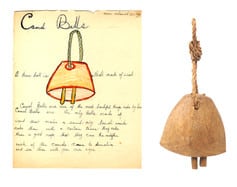Presented by Museum of the Peace Corps Experience and American University Museum
Student’s school project (left)
Omar Mohamed, c. 1969
Hargeisa, Northern region, Somalia (also known as Somaliland)
Colored pencil on paper
Courtesy of Stanford University Libraries and Jeanne D’Haem
Somalia, Arabsiyo and Hargeisa, 1968–70
Camel bell (right)
Mid-twentieth century
Somalia (also known as Somaliland)
Wood, 6 1/4 x 6 3/4 x 3 1/2 in.
Collection, Museum of the Peace Corps Experience
Gift of Martin Kaplan (Founder, MPCE),
Somalia, Borama (Amoud) and Las Anod 1962–64

I was the English teacher at Ahmed Gurry School in Hargeisa, Somalia, in 1969. For one lesson, I shared magazines from the US with my class and pointed out the advertisements. After I explained the elements in an advertisement, my students were asked to study them in the magazines and then to create one about Somalia. Soon after I collected these student papers, all Peace Corps volunteers unfortunately had to leave Somalia due to a military coup. I never had the opportunity to grade and return them to my class. Perhaps one of my students will see them in the museum exhibit!
Omar Mohamed created an advertisement for camel bells like the one donated by Martin Kaplan, another Somali volunteer. Omar will tell you what is special about a camel bell:
“Camel Bells”
A true bell is a bell made of wood.
Camel Bells are one of the most beautiful things made by Somalis.
Camel Bells are the only bell made of wood that make a sound.
Only Somali nomads make them with certain trees.
They make a good rope that they can tie easily on the neck of the camels.
Come to Somalia and see them with your own eyes.
The Committee for a Museum of the Peace Corps Experience is a 501(c)(3) private nonprofit organization. Tax ID: EIN # 93-1289853
The Museum is not affiliated with the U.S. Peace Corps and not acting on behalf of the U.S. Peace Corps.
Museum of the Peace Corps Experience © 2024. All Rights Reserved.